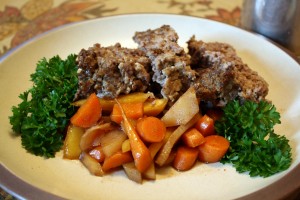This past weekend, we made 10 different meals. Two of the meals got quite a positive response and I was asked to post them here. The dishes are a Pomegranate and Raspberry Wine Pork and a Mushroom and Barley Stew. Both dishes are fairly easy to create and I hope you like them.
Pomegranate and Raspberry Wine Pork
Ingredients:
1 pork shoulder (4 – 5 lbs)
2 cups of pomegranate juice (unsweetened)
2 cups of Raspberry wine
1 tsp black pepper
1 tsp sea salt
Place the pork in a large pot and add the wine and juice together and cook on a stovetop on medium heat for 2.5 hours. After the first hour, add the black pepper. After the second hour, add the salt. The pork is done when it falls apart (like pulled pork). We served it with the Mushroom and Barley stew. It also works well with Wild or Brown Rice.
Mushroom and Barley Stew
Ingredients:
2 medium onions diced
4 cups of button mushrooms, chopped (portobello mushrooms may be used instead)
3 cloves of garlic, minced
1.5 cups of barley
3 cups of water
2 tbsp olive oil
salt and pepper to taste
In a large pot on medium heat, add the olive oil and onions. Sweat (cook) the onions until clear, add half of the mushrooms and stir occasionally. After the mushrooms have cooked down a bit, add the rest of the mushrooms. Add the barley, garlic, and water. Continue to simmer over medium heat, stirring occasionally. Keep an eye on the barley so that it doesn’t scorch. The goal is that the barley should be al dente and tender. Take off of the heat and let set for 5 minutes, stirring at 2.5 minutes and another stir at 5 minutes. Serve.

